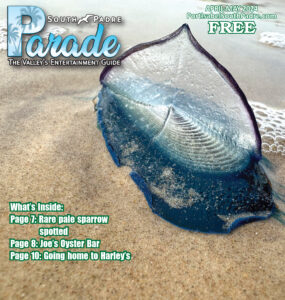By STEVE HATHCOCK
Special to the PRESS
I have received several emails asking about metal detecting on the beaches of Padre Island.
The laws on metal detecting are rather vague and for the most part, loosely enforced. I have been metal detecting on the beaches of Padre Island for over 20 years and have yet to be told not to do it. But that’s not to say that it is legal. You can look up Texas Antiquities Act online, which can give you some insight into the law.
The Antiquities Code of Texas was enacted in the late 1960s after a group of treasure hunters located and salvaged one of the Spanish ships that wrecked on Padre Island in 1554. Basically, the code prohibits metal detecting within a certain distance of known wrecks or other historically significant sites.
It is DEFINITELY illegal to metal detect on North Padre Island, as it is part of the National Seashore. South Padre Island itself is mostly made up of private owners with a few government entities such as Texas Parks and Wildlife, the Willacy County Irrigation District and a nature conservancy group. Together, those three control most of the land near the “Cut” (Port Mansfield Channel) and you would be wise to use caution so that you are not hunting on their properties, most of which are clearly posted.
I follow a certain set of self-imposed rules, which include asking permission before commencing a hunt on private property, no hunting or digging in the dunes, always burying any holes I dig. Picking up trash including any pop-tops or beer cans I locate and just generally being a good steward of the land.
I generally like to hunt areas where there are tourists. People ask me what I can expect to find and I tell them to “observe what people are wearing on the beach. That is what you will find.”
L.Q. of Racine, Wisconsin was hunting near access road 5 when he located a 1945 dos peso (Mexico) coin, which contains about one-twentieth of an ounce of gold. In today’s market, its bullion value is around $62.
Lots of coins, beer cans and pop-tops have been found in Isla Blanca Park on the southern tip of the Island but the most common piece of jewelry seems to be toe rings.
Want the whole story? Pick up a copy of the Port Isabel-South Padre Press, or subscribe to our E-Edition by clicking here.


2 comments
Hmm, if you are detecting on the beach itself, the landowners shouldn’t have anything to say about it since the Texas Open Beaches Act gives the public access. I’d love to see someone posting that I cannot go on “their beach.” Of course, local and county ordinances are a different matter.
We found some cool stuff on the beach over the years. It’s a lot of fun combing the beach. Just thought you might find our story a little interesting. 2 years ago in February we found a message in a bottle on Boca Chica beach. It was a Florida school project. This year I found an aluminum Japanese net float on the north end of SPI beach. How it got here?? Enjoy your articles in the Parade. Keep up the good work.
Winter Texan…Tom